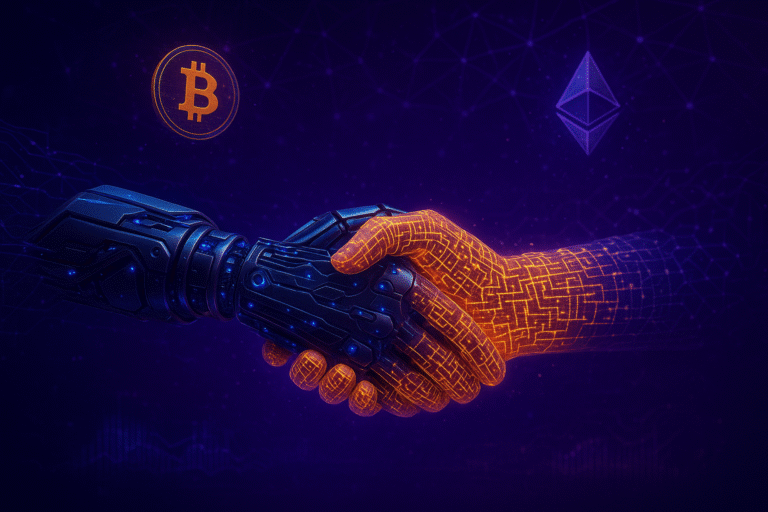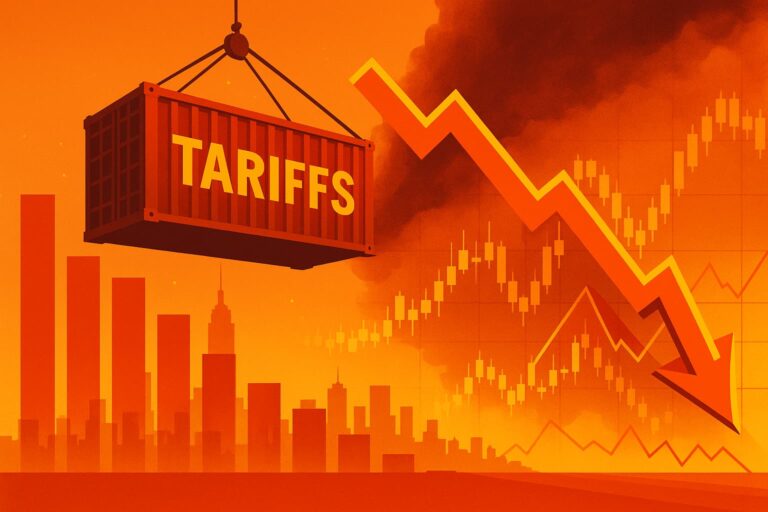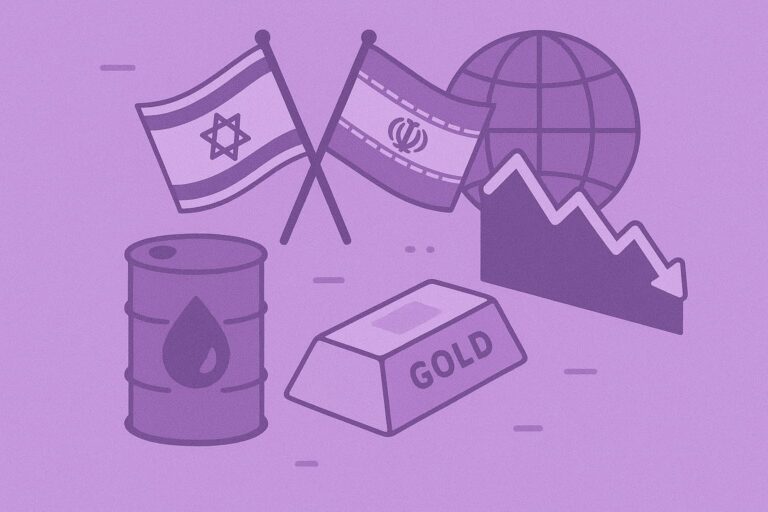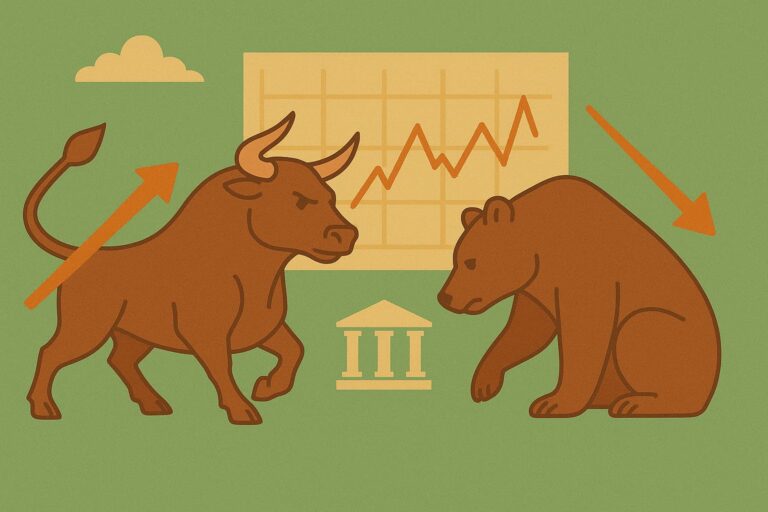In einer zunehmend vernetzten Welt werden die Finanzmärkte nicht mehr nur von Gewinnberichten oder Zinssätzen bestimmt, sondern sind inzwischen eng verflochten mit geopolitische Ereignisse. Im Jahr 2025 werden die Auswirkungen der Kriege, Wahlen, Handelsstreitigkeiten und Cyber-Bedrohungen sind ausgeprägter denn je und schlagen Wellen an den Aktienmärkten, bei Rohstoffen, Währungen und Kryptowährungen gleichermaßen.
Von Washington bis Peking und vom Nahen Osten bis Osteuropa zeichnen geopolitische Spannungen die Landkarte der globalen Finanzwelt neu.
Was ist ein geopolitisches Risiko?
Geopolitisches Risiko bezieht sich darauf, wie politische Entscheidungen, internationale Konflikte oder globale Machtverschiebungen das Vertrauen der Anleger, die Wirtschaftstätigkeit und die Preisbildung von Vermögenswerten beeinflussen.
Zu diesen Risiken gehören:
- Krieg und militärische Konflikte
- Handelssanktionen oder Zölle
- Politische Instabilität oder Regimewechsel
- Ressourcennationalismus (z. B. Öl, seltene Erden)
- Globale Bündnisse und Machtblöcke (z. B. NATO, BRICS)
- Cyber-Kriegsführung und digitale Spionage
Geopolitische Schlüsselfaktoren im Jahr 2025
1. China gegen den Westen: Handel und Technologie
Spannungen zwischen China und die westlichen Volkswirtschafteninsbesondere die USA, haben sich im Jahr 2025 intensiviert. Auch wenn eine vollständige Entkopplung noch nicht stattgefunden hat, verfolgen beide Seiten aggressiv die technische Souveränität.
- Ausfuhrbeschränkungen auf Halbleitern, KI-Chips und Quantentechnologie haben zu Volatilität im Technologiesektor.
- Die BRICS+-Bündnisdie inzwischen auf Länder wie Saudi-Arabien und Indonesien ausgeweitet wurde, entwickelt aktiv Alternativen zu westlichen Finanzsystemen.
Auswirkungen auf den Markt:
- Die US-Chiphersteller (z. B. Nvidia, AMD) sehen sich mit kurzfristigen Störungen konfrontiert.
- Die aufstrebenden Märkte, die den BRICS+ angehören, gewinnen die Aufmerksamkeit der Anleger.
- Die Dominanz des US-Dollars wird auf die Probe gestellt, was die Nachfrage nach Gold und alternative Wertaufbewahrungsmittel.
2. Krisenherde im Nahen Osten und Ölpreisvolatilität
Die Unruhen im Nahen Osten, insbesondere um die Iran-Israel-Konflikt und die Spannungen im Roten Meer haben die weltweiten Schifffahrtsrouten und Ölströme unterbrochen.
- Die Straße von Hormuz bleibt ein kritischer Engpass.
- Die Ölpreise stiegen Anfang 2025 kurzzeitig auf über $100/Barrel, bevor sie sich stabilisierten.
Auswirkungen auf den Markt:
- Energieaktien und ETFs sind stark angestiegen.
- Inflationserwartungen haben weltweit zugenommen und setzen die Zentralbanken unter Druck.
- Länder, die von Ölimporten abhängig sind (wie Indien und Japan), sehen Währungsdruck.
3. Russland-Ukraine: Der lange Schatten geht weiter
Auch wenn die Russland-Ukraine-Konflikt in eine längere Phase eingetreten ist, ist sein Einfluss auf die Energie-, Agrar- und Rüstungsaktien immer noch erheblich.
- Weizen- und Düngemittelmärkte gestört bleiben.
- Die europäischen Nationen erhöhen Militärausgabendie den Unternehmen der Luft- und Raumfahrt sowie der Verteidigungsindustrie zugute kommen.
Auswirkungen auf den Markt:
- Die Anleger verlagern ihr Gewicht auf defensive Sektoren (Versorgungsunternehmen, Verteidigung, Grundnahrungsmittel).
- Europäische Märkte bleiben fragmentiert und zurückhaltendDas Kapital fließt in die USA und nach Asien.
4. Globale Wahlen und Populismus
Wichtige Wahlen in der USA, Indien, die EU und Lateinamerika tragen zur Unsicherheit der politischen Aussichten bei.
- Populistische Parteien sind im Aufwind und erhöhen die Volatilität in den Bereichen Steuern, Unternehmensregulierung und Handelspolitik.
- Die Nachwehen der Präsidentschaftswahlen 2024 in den USA wird auch im Jahr 2025 die Politik bestimmen, insbesondere in Bezug auf die Haushaltsausgaben und die Ausrichtung der Zinssätze.
Auswirkungen auf den Markt:
- Die Anleger sind misstrauisch gegenüber politisches Schleudertraumaund bevorzugt Unternehmen mit globaler Diversifizierung.
- Infrastruktur und Verteidigung Die Ausgabenthemen bleiben stark.
5. Digitale Souveränität und Cyberkriege
Während sich KI und digitale Vermögenswerte durchsetzen, streiten sich die Regierungen um Datenkontrolle, Verschlüsselungsstandards und Blockchain-Regulierung.
- Mehrere hochkarätige Cyberangriffe Anfang 2025 (auf europäischen Banken und asiatischen Börsen) haben Rufe nach digitalem Protektionismus laut werden lassen.
- Die Nationen bauen staatlich unterstützte digitale Währungen (CBDCs) um der Abhängigkeit vom US-Dollar und privaten Kryptowährungen entgegenzuwirken.
Auswirkungen auf den Markt:
- Erhöhte Nachfrage nach Cybersicherheits-Aktien.
- Kryptomärkte sind sehr empfindlich auf Regulierung reagieren und Nachrichten über Datenschutzverletzungen.
- Investoren bevorzugen "sicherer Hafen" für digitale Vermögenswerte wie Bitcoin und tokenisiertes Gold.
Wie die Anleger reagieren
1. Flucht in die Sicherheit
Wenn die Ungewissheit zunimmt, wenden sich die Anleger traditionell anderen Themen zu:
- Gold
- U.S. Staatsanleihen
- Defensive Sektoren (Gesundheitswesen, Versorger, Basiskonsumgüter)
- Stabile dividendenstarke Aktien
2. Diversifizierung des Portfolios
Investoren sind zunehmend:
- Mehr Mittelzuweisung für Schwellenländer-ETFs außerhalb der traditionellen U.S./EU-Bestände.
- Ausgewogene Portfolios mit Rohstoffe, REITsund alternative Anlagen.
3. Der Aufstieg der geopolitischen ETFs
Neue ETFs mit Schwerpunkt auf Verteidigung, Cybersicherheit und Rohstoffe die mit instabilen Regionen verbunden sind, gewinnen im Jahr 2025 an Bedeutung.
Beispiele hierfür sind:
- ITA (iShares U.S. Aerospace & Defense)
- CIBR (Cybersecurity ETF)
- GUNR (ETF für natürliche Ressourcen)
Chancen in der Ungewissheit
Trotz der Risiken können geopolitische Umwälzungen Folgendes bieten eindeutige Einstiegspunkte für versierte Investoren:
- Aktien für die Energiewende kann von einer langfristigen Umschichtung in den ölabhängigen Regionen profitieren.
- Unternehmen, die Widerstandsfähigkeit der Lieferkette (z. B. Logistik, Automatisierung) sind gefragt.
- Verteidigung und Luft- und Raumfahrt sind auf ein mehrjähriges Wachstum eingestellt, da die Regierungen ihre Militärbudgets aufstocken.
"Volatilität ist der Preis der Chance". - Das ist die Einstellung, die viele institutionelle Anleger im Jahr 2025 einnehmen.
Tipps für Kleinanleger
- Global diversifiziert bleiben
Konzentrieren Sie nicht alle Bestände auf eine Region oder einen Sektor. Nutzen Sie internationale ETFs oder Investmentfonds für ein ausgewogenes Engagement. - Verfolgen Sie die Nachrichten - aber geraten Sie nicht in Panik
Geopolitische Schlagzeilen können Lärm verursachen. Vermeiden Sie emotionale Reaktionen und konzentrieren Sie sich auf die langfristigen Fundamentaldaten. - Absicherungsinstrumente klug einsetzen
Wenn Sie große Portfolios verwalten, sollten Sie Folgendes in Betracht ziehen Stop-Loss-Aufträge, inverse ETFs, oder Warenexposition als Hecken. - Fokus auf widerstandsfähige Unternehmen
Investieren Sie in Unternehmen mit starken Bilanzen, vielfältigen Lieferketten und globaler Präsenz.
Abschließende Überlegungen
Im Jahr 2025, Geopolitik ist nicht mehr nur ein Thema im Hintergrund, sondern steht im Mittelpunkt bei der Gestaltung der Finanzmärkte. Von wechselnden Allianzen über Ressourcenkriege bis hin zu Kämpfen um digitale Souveränität - die Weltwirtschaft befindet sich in einer turbulenten, aber transformativen Phase.
Der Schlüssel für Investoren ist nicht die Angst vor Volatilität, sondern die sie zu verstehen, sich auf sie vorzubereiten und sie gelegentlich zu nutzen.
Die Welt mag durch die Politik geteilt sein, aber die Märkte sind durch das Kapital geeint. Bleiben Sie informiert, bleiben Sie beweglich und bleiben Sie diversifiziert.





